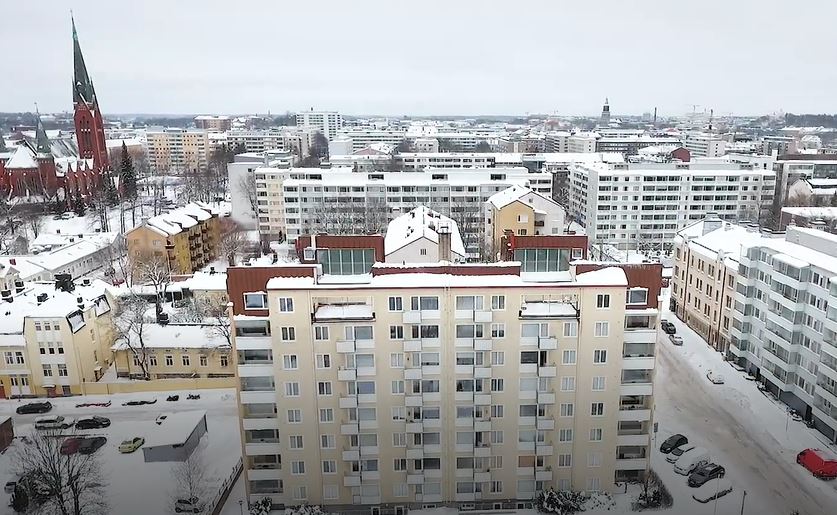Thanks to the JÄSPI heat recovery system, the Turku-based housing company has saved EUR 34,000 in energy costs in a couple of years. A renovation that lasted only two months will pay for itself in less than seven years. Watch the video!
The energy renovation did not increase the maintenance charge of the condominium
Up to half of the property’s district heating consumption is blown into the sky through ventilation. However, with the exhaust air heat recovery system (LTO), the heat wasted can be efficiently recovered and utilized for heating the property and its hot water.
In the Turku-based housing company, the heating renovation was started two and a half years ago. There has been more than satisfaction with the result. The total savings in energy consumption in Asunto Oy Sofianlinna have been 38 percent. In two and a half years, the Jäspi heat recovery system has achieved savings in the company’s energy costs of more than EUR 34,000.
– Financially, the project was very profitable. The energy savings achieved are sufficient to pay the installments and interest on the care loan raised annually for the project, with some remaining remaining. Thus, the housing company received virtually new equipment and modern technology free of charge, without having to increase the care fee, says the property manager (AIT), Bachelor of Business Administration Esko Lämsä from Varsinais-Suomen Isännöintitalo Oy.
According to Lämsä, the company may, if it wishes, reduce the maintanance fee once the loan has been paid.
Old fans were at the end of their life span
Asunto Oy Sofianlinna is an eight-storey apartment building built in 1957 in Turku, with a total of 72 residential apartments and two commercial premises.
The apartment building, located close to the city center, belongs to the district heating network and about 656 MWh of district heating had been consumed annually. As is often the case in apartment buildings of this age, Asunto Oy Sofianlinna had also had mechanical exhaust ventilation, which was taken care of by two original, belt-driven chamber room fans located in the attic floor of the house. The property’s exhaust air volume is rated at 2.3 m3 / s, and in connection with the renovation, the old fans were replaced with modern, frequency-converter-controlled equipment.
In the housing association, the heat recovery project had been under consideration for some time, as the property’s exhaust air fans had reached the end of their technical life and there was room for improvement in the air quality of the apartments. Project planning was carried out by an impartial planning and control body, which also tendered the contract.
– Tipitek Oy, an HVAC and energy expert operating in the Turku region, was chosen to carry out the contract, and it had a good plan and a competitive price, Lämsä says.
An accurate plan ensures the correct dimensioning
Project manager Niko Lappalainen from Tipitek Oy says that the LTO design of the property carefully examines the property’s exhaust air volume, replacement air routes and the need for heating power. They are related together to design a system of the right size.
The heat recovery project was implemented in the spring and summer of 2016. During the renovation, the old chamber fans were removed and replaced by two new heat recovery fans belonging to the JÄSPI LTO product family.
The existing district heating exchanger of the housing association did not need to be replaced. A 60 kW heat pump JÄMÄ STAR, rated according to the exhaust air volume of the property, was connected to the substation center.
The new JÄSPI LTO system generates energy for the property’s circulating radiator network and treats hot water preheating. District heating only takes care of the need for additional energy.
The result is significant savings and better indoor air
Lappalainen says that with a properly designed LTO system, significant savings can be expected.
– Consumption of district heating generally drops by 50-60 percent, as in this area. Of course, heat pumps consume electricity, so be prepared for that. Still, the savings in total energy consumption will be in the range of about 30-40 percent, depending on the destination, he estimates.
Lappalainen emphasizes that it is always worthwhile to combine ventilation sooting and control with the control of a radiator or underfloor heating network.
It is also sensible to implement the heat recovery system project in connection with line renovation.
The correct operation of Asunto Oy Sofianlinnan Jäspi heat recovery system is ensured by the Talothtori remote management and control software. It also reports automatically on a monthly basis the savings achieved, so they are accurately known. The members of the company’s Board of Directors have also been given reading codes in the monitoring software if they wish, and energy consumption has since been closely monitored.
The LTO project will also improve indoor air quality and significantly reduce the housing company’s CO2 emissions compared to baseline.
Fact: Asunto Oy Sofianlinna, Turku
- Built in year 1957
- Jäspi LTO system installed in 2016
- The total cost of the project was EUR 131,860
- Total savings in energy consumption 38%
- Savings over 2.5 years 34,000 euros


